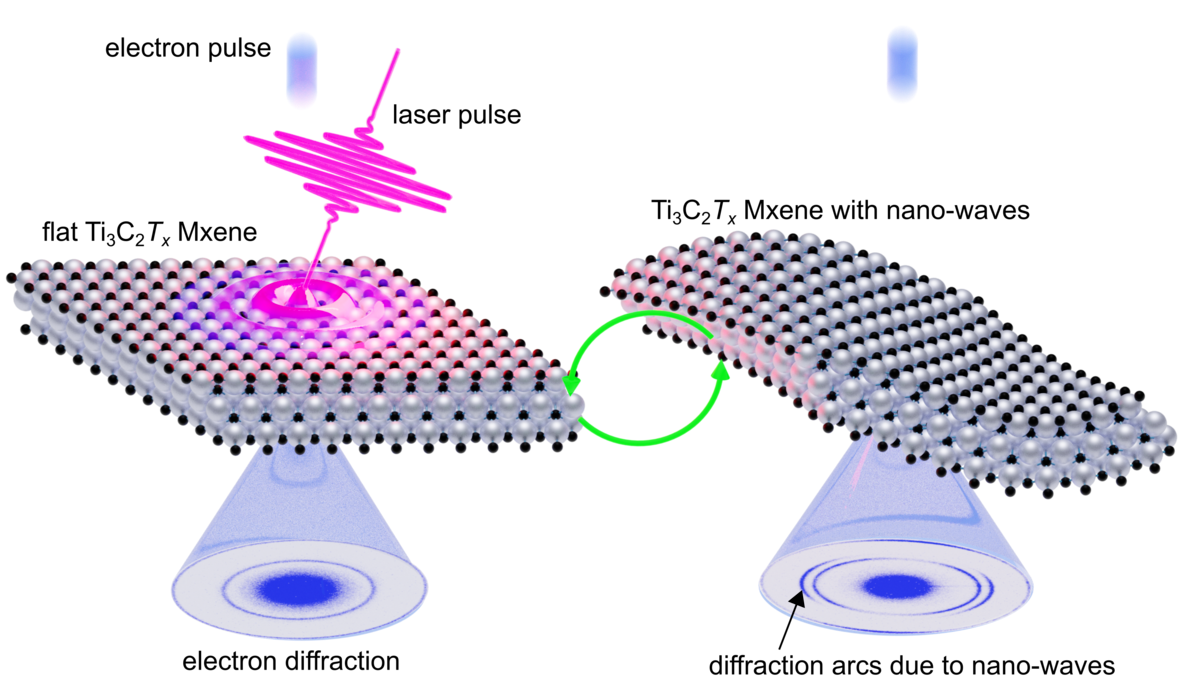Reviewed by Alex SmithSep 2 2021
A spectroscopic technique called ultrafast laser spectroscopy enables the motion of atoms to be observed at their natural time scales in the range of femtoseconds, that is, one-millionth of a billionth of a second. By contrast, electron microscopy offers an atomic spatial resolution.
 Ultrafast electron diffraction reveals photo-switchable nanoripples in MXene nanosheet. Image Credit: Mikhail Volkov.
Ultrafast electron diffraction reveals photo-switchable nanoripples in MXene nanosheet. Image Credit: Mikhail Volkov.
A research team led by Professor Peter Baum at the University of Konstanz combined photons and electrons in a single instrument to develop some of the fastest electron microscopes to achieve a complete understanding of materials and their dynamics at ultimate resolutions in both time and space.
In their latest publication in the journal ACS Nano, researchers from the Baum laboratory have employed this method together with collaborators from ETH Zurich to study novel materials — two-dimensional molecularly defined sheets known as MXenes — and achieved a surprising breakthrough. Laser pulses can be used to switch MXenes repeatedly between a flat and a rippled shape, thereby unraveling a wide spectrum of potential applications.
MXenes: Novel Two-Dimensional Materials
MXenes are two-dimensional sheets of transition metal nitrides or carbides in the form of few-atom-thick single layers.
Dr. Mikhail Volkov, the first author of the recent study, explains the structure of MXenes: “MXenes are comparable to a molecule in one spatial dimension and to an extended solid in the other two.” The process of synthesizing MXenes is called exfoliation, which involves “peeling off” thin layers of material from a precursor material.
When compared to a majority of the other single-layer materials, it is possible to produce a large quantity of MXenes using a scalable and irreversible chemical exfoliation method. It is viable to tune the physical and chemical properties of MXenes by choosing the right transition metal, resulting in widespread applications of MXenes in energy storage, sensing, antibacterial action and light harvesting.
Nano-Waves in MXenes Formed by Fast Light
As part of their study, primary investigators Dr. Mikhail Volkov from the University of Konstanz and Dr. Elena Willinger from ETH Zurich devised a new approach to improve the properties of MXenes by shining fast light pulses on them.
The researchers employed ultrafast electron microscopy along with an atomic spatial resolution to record a movie of MXenes interacting with femtosecond laser pulses. This demonstrated that the laser energy transfers to the atomic lattice in a record-breaking time of just 230 fs.
Surprisingly, the researchers also discovered that the femtosecond laser light can be applied to switch back and forth between the originally flat surface structure of the MXene and a nano-wave form of the material — a hill-and-valley “nano-landscape” exhibiting a periodicity more than 50 times finer compared to the laser wavelength.
We can control the nano-wave’s orientation with the polarization of the laser, which means the material has an optical memory on the nanoscale. Moreover, if the laser strikes again, the nano-waved MXene turns back into a plane and remains flat during illumination.
Dr. Mikhail Volkov, Study First Author, University of Konstanz
“The extremely small size of the nano-waves and the fast lattice reaction are also quite surprising, and a phenomenon called plasmon-phonon coupling is likely involved,” added Volkov.
Nano-Waves Boosting Material Performance
Nano-structuring in the form of waves also increases the surface-to-volume ratio of the materials, making them chemically more reactive. In addition, it enhances the local electro-magnetic fields, improving the coupling with light—a valuable property for sensing applications.
Dr. Mikhail Volkov, Study First Author, University of Konstanz
Thus, the researchers predict that the discovered nano-waved MXenes will exhibit higher energy storage capacity and better antibiotic or catalytic activity.
Finally, the possibility to switch the structure of MXenes between plane and wavy ‘on demand’ via a laser pulse opens up intriguing ways to use the materials in active plasmonic, chemical and electric devices.
Dr. Mikhail Volkov, Study First Author, University of Konstanz
Journal Reference:
Volkov, M., et al. (2021) Photo-Switchable Nanoripples in Ti3C2Tx MXene. ACS Nano. doi.org/10.1021/acsnano.1c03635.